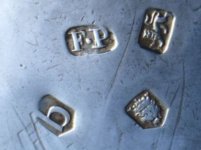tamrock
Gold Member
- Jan 16, 2013
- 15,447
- 31,341
- Detector(s) used
- Bounty Hunter Tracker IV
- Primary Interest:
- All Treasure Hunting
I just picked this up about an hour ago for dirt cheap. It looks like pure silver and is constructed like very old silver, but the hallmarks are certainly odd for any of the British hallmarks I'm somewhat familiar with. The Kings mark isn't like any standard for the era's used and it's missing the city mark and date mark. The raised paw Lion even seems a bit off to me. Red Coat if your out there, I need your opinion as to what these marks might be saying? It's definitely stamped with a clear makers mark I assume F P. If it is sterling I made a great little score but I'll wait to see what member RC has to say before I run down to the coin shop and have them shoot a beam with their expensive XRF gun. I kinda feel like a bit of a pest when they say is good silver and I decline to sell.













